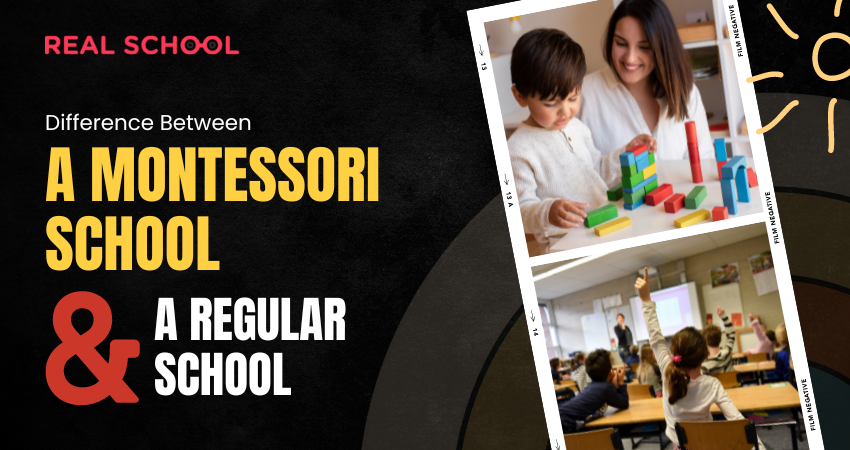In the realm of education, parents often find themselves navigating a myriad of options when it comes to choosing the best learning environment for their children. Two prominent choices are Montessori schools and regular schools. Both approaches aim to provide quality education, but they have distinct philosophies and methodologies. This article delves into the differences between Montessori schools and regular schools, shedding light on their unique features, teaching methods, and benefits.
1. Montessori Education: Fostering Independence
Philosophy and Approach: Montessori education emphasizes hands-on learning, self-directed activities, and collaborative play. It aims to nurture a child’s natural curiosity and promote independent thinking.
Classroom Environment: Montessori classrooms are carefully designed with child-sized furniture and materials that encourage exploration. Children choose their activities, fostering a sense of autonomy.
2. Traditional Education: Structured Learning
Traditional Approach: Regular schools follow a structured curriculum designed by education boards. The teacher plays a central role in imparting knowledge, and students adhere to a set schedule.
Classroom Setup: Traditional classrooms often have desks facing the teacher, promoting a teacher-centered learning environment. Interaction is structured, and subjects are taught in specific time slots.
Also Read: How to Create a Montessori Environment at Home
3. Individualized Learning in Montessori Schools
Personalized Curriculum: Montessori schools tailor activities to each child’s pace and interests. This approach allows students to delve deeper into subjects they are passionate about.
Multi-Age Grouping: Montessori classrooms often have students of varying ages. Younger children learn from older peers, while older students reinforce their learning by teaching.
4. Uniform Education in Regular Schools
Standardized Curriculum: Regular schools follow a standardized curriculum set by educational authorities. All students within a grade learn the same material at the same pace.
Same-Age Grouping: Students in regular schools are usually grouped by age, with each grade level progressing together.
5. Hands-On Learning in Montessori
Sensorial Exploration: Montessori education emphasizes learning through the senses. Children engage with tactile materials that enhance understanding of concepts like math and language.
Practical Life Skills: Practical tasks like pouring water, tying shoelaces, and cleaning develop fine motor skills, independence, and a sense of responsibility.
6. Theory-Based Learning in Regular Schools
Theoretical Instruction: Traditional schools focus on theoretical knowledge dissemination through lectures, textbooks, and assignments. Students gain foundational knowledge to prepare for standardized tests.
7. Teacher’s Role in Montessori
Guide and Facilitator: Montessori teachers act as guides, observing each child’s progress and offering assistance when needed. They encourage self-discovery and problem-solving.
Child-Centered Approach: The teacher’s role is to create a supportive environment that allows children to explore and learn at their own pace.
8. Teacher-Centric Approach in Regular Schools
Knowledge Transmitter: In regular schools, teachers are the primary source of information. They deliver lessons, assign homework, and assess student understanding through tests and quizzes.
9. Freedom of Movement in Montessori
Unrestricted Exploration: Montessori classrooms permit children to move around freely and choose activities independently. This freedom fosters a sense of responsibility and self-regulation.
10. Structured Environment in Regular Schools
Defined Rules: Regular schools typically have stricter rules regarding movement and behavior. Students follow a set timetable, changing classrooms for different subjects.
In conclusion, Montessori schools and regular schools have divergent educational philosophies and teaching methodologies. Montessori schools prioritize independent learning, hands-on experiences, and individualized attention, fostering holistic development. On the other hand, regular schools focus on structured curricula, theoretical instruction, and standardized assessments. The choice between the two depends on a parent’s values, a child’s learning style, and the desired educational outcomes.
FAQs:
Q1: Which approach is better for my child’s development?
A1: The choice depends on your child’s learning style and your educational preferences. Montessori schools emphasize independence and experiential learning, while regular schools provide structured instruction.
Q2: Are Montessori schools only for younger children?
A2: Montessori education is typically associated with early childhood, but there are Montessori programs for older students as well.
Q3: Do regular schools offer hands-on learning?
A3: While regular schools may incorporate practical activities, their primary focus is on theoretical instruction and standardized testing.
Q4: How do Montessori teachers manage multi-age classrooms?
A4: Montessori teachers use peer learning and individualized activities to accommodate students of varying ages and skill levels.
Q5: Which approach prepares students better for standardized tests?
A5: Regular schools tend to focus more on theoretical knowledge and test preparation, which may align better with standardized testing requirements.







